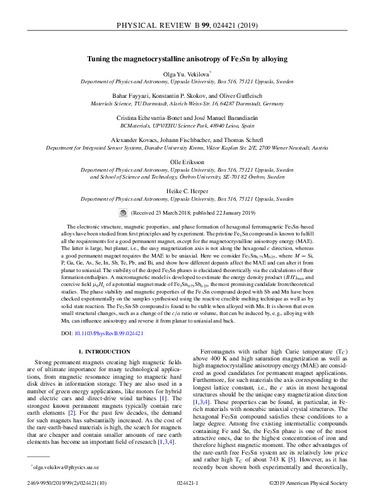Tuning the magnetocrystalline anisotropy of Fe3Sn by alloying
Palabra(s) clave:
imanes permanentes
magnetismo
Fecha de publicación:
Editorial:
American Physical Society
Versión del editor:
Citación:
Descripción física:
Resumen:
The electronic structure, magnetic properties, and phase formation of hexagonal ferromagnetic Fe3Sn-based alloys have been studied from first principles and by experiment. The pristine Fe3Sn compound is known to fulfill all the requirements for a good permanent magnet, except for the magnetocrystalline anisotropy energy (MAE). The latter is large, but planar, i.e., the easy magnetization axis is not along the hexagonal c direction, whereas a good permanent magnet requires the MAE to be uniaxial. Here we consider Fe3Sn0.75M0.25, where M= Si, P, Ga, Ge, As, Se, In, Sb, Te, Pb, and Bi, and show how different dopants affect the MAE and can alter it from planar to uniaxial. The stability of the doped Fe3Sn phases is elucidated theoretically via the calculations of their formation enthalpies. A micromagnetic model is developed to estimate the energy density product (BH)max and coercive field μ0Hc of a potential magnet made of Fe3Sn0.75Sb0.25, the most promising candidate from theoretical studies. The phase stability and magnetic properties of the Fe3Sn compound doped with Sb and Mn have been checked experimentally on the samples synthesised using the reactive crucible melting technique as well as by solid state reaction. The Fe3Sn-Sb compound is found to be stable when alloyed with Mn. It is shown that even small structural changes, such as a change of the c/a ratio or volume, that can be induced by, e.g., alloying with Mn, can influence anisotropy and reverse it from planar to uniaxial and back.
The electronic structure, magnetic properties, and phase formation of hexagonal ferromagnetic Fe3Sn-based alloys have been studied from first principles and by experiment. The pristine Fe3Sn compound is known to fulfill all the requirements for a good permanent magnet, except for the magnetocrystalline anisotropy energy (MAE). The latter is large, but planar, i.e., the easy magnetization axis is not along the hexagonal c direction, whereas a good permanent magnet requires the MAE to be uniaxial. Here we consider Fe3Sn0.75M0.25, where M= Si, P, Ga, Ge, As, Se, In, Sb, Te, Pb, and Bi, and show how different dopants affect the MAE and can alter it from planar to uniaxial. The stability of the doped Fe3Sn phases is elucidated theoretically via the calculations of their formation enthalpies. A micromagnetic model is developed to estimate the energy density product (BH)max and coercive field μ0Hc of a potential magnet made of Fe3Sn0.75Sb0.25, the most promising candidate from theoretical studies. The phase stability and magnetic properties of the Fe3Sn compound doped with Sb and Mn have been checked experimentally on the samples synthesised using the reactive crucible melting technique as well as by solid state reaction. The Fe3Sn-Sb compound is found to be stable when alloyed with Mn. It is shown that even small structural changes, such as a change of the c/a ratio or volume, that can be induced by, e.g., alloying with Mn, can influence anisotropy and reverse it from planar to uniaxial and back.
Patrocinado por:
Authors acknowledge support from NOVAMAG project, under Grant Agreement No. 686056, EU Horizon 2020 Framework Programme. The computations were performed on resources provided by the Swedish National Infrastructure for Computing (SNIC) at PDC and NSC centers. O.E. acknowledges support from STandUPP, eSSENCE, the Swedish Research Council and the KAW foundation (Grants No. 2012.0031 and No. 2013.0020). O.G. acknowledges the Hessen LOEWE Response Programme. Authors are thankful to Dr. Y. Kvashnin for useful discussions.
Colecciones
- Artículos [37543]
- Física [2001]
- Investigaciones y Documentos OpenAIRE [8372]
Ficheros en el ítem




